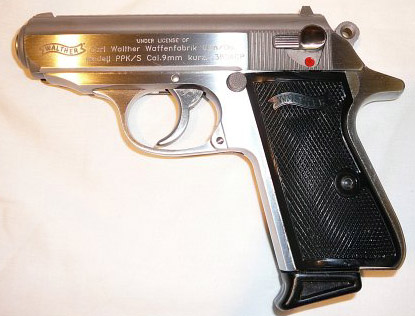|
Walther PPK/S .380 ACP Pistol By David Tong  The German firm of Carl Walther Waffenfabrik created the first popular double-action semi-automatic pistol in 1929 when they introduced the Model PP, which stands for �Polizei Pistole� (police pistol). Generally seen in 7.65 millimeter/.32 Automatic or 9x17 millimeter/.380 ACP calibers, this medium-size, all-steel pistol has a weight of 23 ounces, empty, with a 3.9 inch barrel and an eight shot magazine capacity in .32, reduced to seven rounds in the larger .380 caliber. In 1931, the firm introduced the PPK, intended for plainclothes concealed detective officers. I�m not sure why this has become the archetype for many blowback small auto pistols, or why Ian Fleming�s James Bond was issued one, as the PP is quite small enough for a police sidearm, but there you are. The pistol has a 3.3 inch barrel, as well as a reduced butt length, losing one round of magazine capacity in either caliber. It featured wrap-around plastic grips instead of the full steel backstrap frame of the PP, shedding about two ounces in the bargain. Fast forward to the U.S. Gun Control Act of 1968, passed in the aftermath of the Kennedy and King killings. Our Bureau of Alcohol, Tobacco and Firearms (BATF) instituted a point system for allowing or denying the importation of pistols based on size, weight, and features; the popular PPK was denied import as too concealable. Walther responded by grafting the shorter barrel and slide of the PPK to the longer all steel frame of the PP and the (legal for import) PPK/S was born. At the time, the now-defunct Interarms firm of Alexandria, Virginia was the importer of Walther products and in 1978 Interarms had licensed a company in Georgia to produce the pistols domestically. In 1999, Smith & Wesson became the official U.S. importer of all Walther products and in 2007 began manufacturing the PP, PPK and PPK/S series pistols under license from the German Walther company. S&W claims the following product features for their PPK/S.
The test pistol is made of stainless steel, which is good for a handgun that will be worn concealed, sometimes in humid or sweaty environments because of its resistance to corrosion. Smith & Wesson turned to Sturm, Ruger for its casting expertise to produce the frames, which are then shipped to S&W�s plant in Houghton, Maine for final machining and assembly into complete guns. S&W has made two improvements to the pistol�s original design. The first is a lengthening of the rear tang, to help preclude hammer bite on the web of the shooter�s hand. This is a good thing, because those of us with thicker hands can be bitten by either the hammer or the rear of the slide as it recoils.  The second change is hardly ever mentioned in the popular gun press, but was immediately apparent to this two-time �original� PPK owner. The separate frame and barrel feed ramps have now been re-angled and cut into one continuous smooth surface. PPKs of yore were not known for their reliability with modern jacketed hollow point ammunition, which is unsurprising as the pistol was designed for standard, military type, full metal jacketed bullets and this simple change by S&W now makes the old warhorse a viable choice in the modern self-defense pistol market. Here are S&W's technical specifications for their Walther PPK/S.
Due to the low bore center and the fixed barrel, PP and PPK pistols are typically quite accurate as "pocket pistols" go and I had no trouble achieving ten yard steel plate �knockdowns� using either Winchester white box 95 grain FMJ ammo, or Federal 95 grain JHP ammo. Center those tiny sights, squeeze off, and a gratifying �tink� and falling plate are the result. I find the PPK/S much easier to hit with than the typical 2� .38 Special revolver and shooting statistics from Marshall/Sanow�s report indicate near parity in one shot stops with the revolver. I must say, however, that they could and should improve the trigger. While it is somewhat better than what I remember about my pre-war 7.65, it is surely not worth writing home about, unless you send hate mail home. It measured 13 pounds of snatchy pull in double-action and a creepy 6 pound single-action release. I have not really had much of a hankering for a new PPK in over ten years because of some durability issues with the former domestically-produced item, but S&W has given the piece a new lease on life. While I do not expect to buy one anytime soon, nor will it replace the 1911 pistol that I normally carry, I can see it as a back-up gun in certain circumstances. For instance, summer wear when clothing is lighter and more abbreviated. Note: This article is mirrored on the Product Reviews page. |